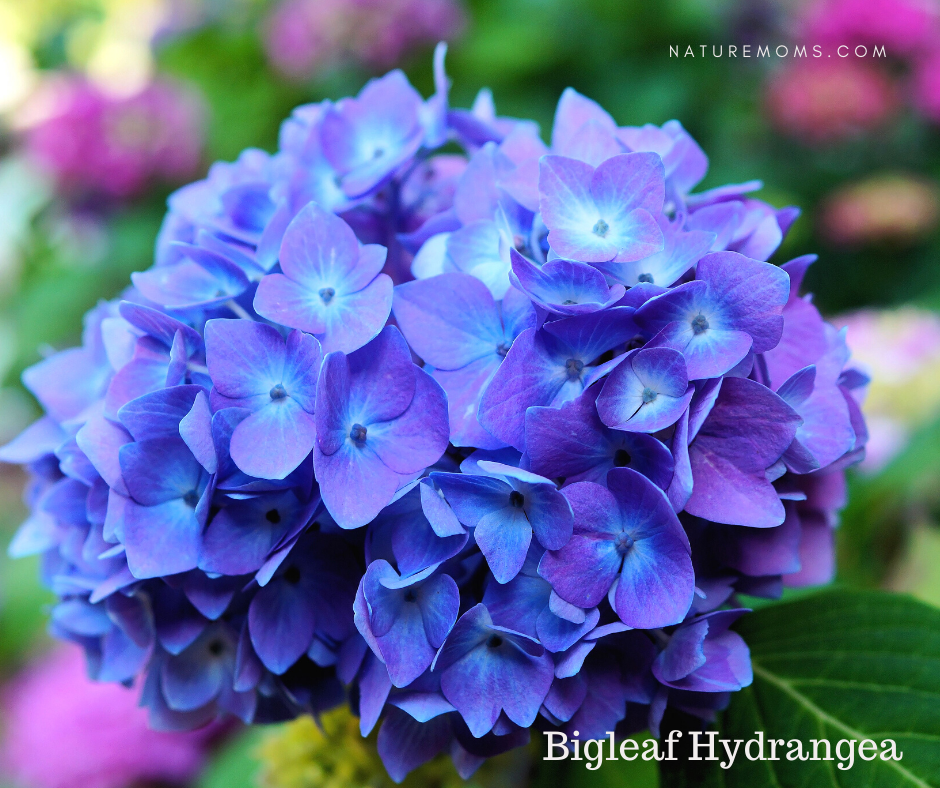 Naming a favorite flower on this gloriously beautiful planet can be a tall order but it is a challenge I can meet in an instant. My absolute favorite flower is the hydrangea. Of course a hydrangea flower can look very different depending on the type of plant in question. There are actually six different types of hydrangea grown here in the USA. The flowers range from cone shaped panicles, to mopheads, to lacecaps. The color varieties are also vast.
Naming a favorite flower on this gloriously beautiful planet can be a tall order but it is a challenge I can meet in an instant. My absolute favorite flower is the hydrangea. Of course a hydrangea flower can look very different depending on the type of plant in question. There are actually six different types of hydrangea grown here in the USA. The flowers range from cone shaped panicles, to mopheads, to lacecaps. The color varieties are also vast.
You can easily spot the different types by the shape of their flowers and the shape and color of their foliage. It is important to identify which type you have or which type you desire because the growing conditions required can vary. Some are divas that you have to baby in order to get a bloom and others are prolific bloomers. Many require only partial sun and others thrive in full sun, provided they get what all hydrangeas love…ample water.
Some bloom on old wood which makes pruning them a risky business. Others bloom on new wood, and others still bloom on both. Caring for each different type can be confusing at best but they are worth the effort! I have five of the six varieties…all but the last one.
I happen to love them all but my love of hydrangea flowers began with the most commonly referred to…the big fluffy globes or mophead flowers that you usually see in a vibrant blue, purple, violet, or pink. They are actually called…

Bigleaf Hydrangeas
Hydrangea macrophylla, also called French, Japanese, florist, or snowball hydrangea. They can have the fluffy globes of flowers or they can have lacecaps. They are winter hardy through zone 5 and usually bloom July through August. They are often found in floral arrangements because they can be real showstoppers. Just look how gorgeous they are!
The flower colors are based upon soil pH. Acidic soil turns blooms blue and alkaline soil produces pink blooms. The in between produces the purples and violets. You can amend your soil either way to try and produce the colors you desire.
That said, many gardeners find these particular plants to be divas depending on the zone. If you have harsh winters that sometimes go into negative temperatures or wishy washy weather with warmth followed by cold snaps or freezes…you may struggle with these. Someone growing in Georgia may have consistent, amazing blooms, while someone in Ohio may have to coddle these plants to get even a couple blooms. The reason for this is because bigleaf hydrangeas typically bloom on old wood. This means that the stalks/growth you have in August is the same growth that will provide blooms the next summer. The blooms set in late summer or early fall for the next year. If you prune, in winter or early spring you may be cutting off your blooms. No flowers for the whole year! This is why many gardeners rarely if ever prune this variety. Because the old wood stalks are unpruned and sticking up in the air they can be damaged by hard freezes and late frosts, once again killing your flowers for the year.
I had a bigleaf hydrangea at my home when I purchased it four years ago. I got a grand total of two flowers in those four years. This year I opted to remove it and put it in a large pot. It will overwinter in the garage to see if I can get this plant producing some consistent flowers!
There is also a variety in this series from Proven Winners called the Let’s Dance series which blooms on old and new wood so it is a reliable bloomer. Bigleaf hydrangeas love morning sun and afternoon shade. In stores look for Endless Summer or the Let’s Dance line.
Mountain Hydrangeas

Hydrangea Serrata, are native to Japan and Korea. They have delicate lacecap flowers with flattened clusters. It is similar to the bigleaf variety but is smaller and more delicate looking. They are not more delicate in constitution though. They have better winter bud hardiness so if you live in a tougher climate, these may be what you are looking for. They are zone 5 hardy and bloom on old wood. There is also a variety in this series from Proven Winners called Tuff Stuff which blooms on old and new wood so it is a reliable bloomer. Just as with bigleaf varieties the color of your blooms can depend on the pH of your soil. Mountain hydrangeas love morning sun and afternoon shade.
Panicle Hydrangeas

Hydrangea Paniculata, also referred to as peegee hydrangeas or hardy hydrangeas are native to southern and eastern China, Korea, Japan and Russia. You may know some of these by their variety types such as the ever popular Limelights, Little Limes, Pinky Winky, or Vanilla Strawberry. They have gorgeous, large cone shaped flowers which are usually creamy white, pink, light red, or lime colored. Often times they start off as one color and change to another as they age. They can be compact like my Bobo hydrangeas that are 3 feet tall or 8 feet tall like my Limelight with many sizes in between. They are a zone 3 hydrangea so VERY winter hardy. They bloom midsummer and they bloom on new wood which means they are very reliable bloomers! They are also the most sun tolerant variety on the market. As long as they are getting sufficient water and nutrients they can thrive in full sun environments.
Smooth Hydrangea

Hydrangea arborescens, commonly known as wild hydrangea, or Annabelles. They are a native hydrangea (southeastern states). Yay!!! They have spherical shaped blooms that can be smaller, Annabelle size (above), or as big as bowling balls, ie Incrediball from (Proven Winners). The bloom colors are typically creamy white, green, or pink. They can do relatively well in sunny locations, are winter hardy (zone 3), and bloom on new wood so you can prune them back each year (1/3) and new growth will bring vibrant blooms. The new wood coupled with large blooms can sometimes mean the stalks will droop if hit by heavy wind or rain so you may find you need to stake or support these plants if you want them to look their best.
Oakleaf Hydrangea

Hydrangea quercifolia, or oakleaf hydrangea is named for its oak shaped leaves, and is another hydrangea native to the Southeastern United States. The blooms look very similar to the panicle hydrangea with cone shaped blooms. They typically start out white, age to pink, and then finally to a tan color. They are zone 5 hardy and they bloom on old wood. It loves woodlands or partial shade environments and blooms from June to September so it has a long blooming season. The blooms often remain through winter and look lovely in snowfall and in the fall the foliage is a gorgeous purple so it is very nearly a four season plant.
Climbing Hydrangea

Hydrangea petiolaris or climbing hydrangea is a species of hydrangea native to Japan, Korea, and Siberia. It is the only variety I do not have and have no interest in because the ones I have seen are HUGE…as in 3 to 4 stories tall! They are winter hardy, zone 4 plants and they climb via aerial roots (above ground roots). It is a June/July bloomer and the blooms are creamy white lacecaps with dark green, heart shaped foliage. They are often seen climbing trees, chimneys, or a trellis.
Hopefully I hit on all the major aspects of hydrangea growing and the major differences/issues with the different types. Enjoy!



